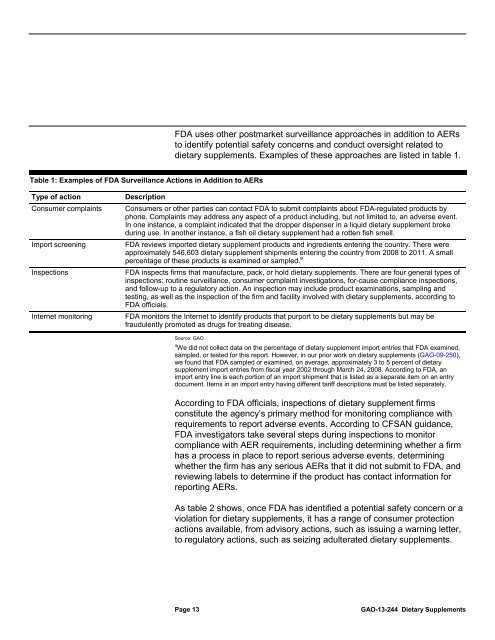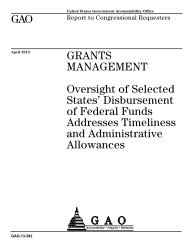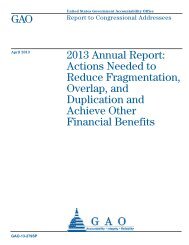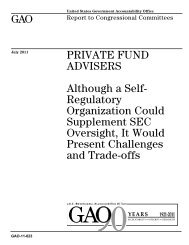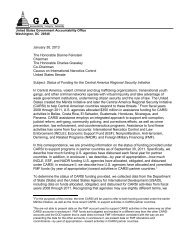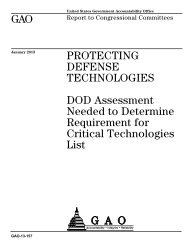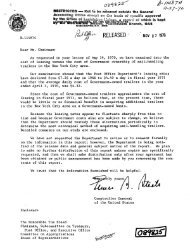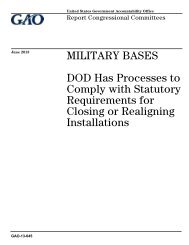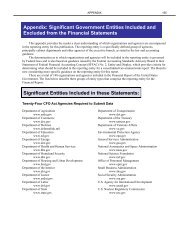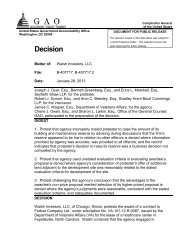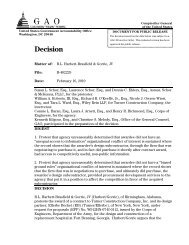Dietary supplements: FDA may have opportunities to expand its use
Dietary supplements: FDA may have opportunities to expand its use
Dietary supplements: FDA may have opportunities to expand its use
You also want an ePaper? Increase the reach of your titles
YUMPU automatically turns print PDFs into web optimized ePapers that Google loves.
<strong>FDA</strong> <strong>use</strong>s other postmarket surveillance approaches in addition <strong>to</strong> AERs<br />
<strong>to</strong> identify potential safety concerns and conduct oversight related <strong>to</strong><br />
dietary <strong>supplements</strong>. Examples of these approaches are listed in table 1.<br />
Table 1: Examples of <strong>FDA</strong> Surveillance Actions in Addition <strong>to</strong> AERs<br />
Type of action<br />
Consumer complaints<br />
Import screening<br />
Inspections<br />
Internet moni<strong>to</strong>ring<br />
Description<br />
Consumers or other parties can contact <strong>FDA</strong> <strong>to</strong> submit complaints about <strong>FDA</strong>-regulated products by<br />
phone. Complaints <strong>may</strong> address any aspect of a product including, but not limited <strong>to</strong>, an adverse event.<br />
In one instance, a complaint indicated that the dropper dispenser in a liquid dietary supplement broke<br />
during <strong>use</strong>. In another instance, a fish oil dietary supplement had a rotten fish smell.<br />
<strong>FDA</strong> reviews imported dietary supplement products and ingredients entering the country. There were<br />
approximately 546,603 dietary supplement shipments entering the country from 2008 <strong>to</strong> 2011. A small<br />
percentage of these products is examined or sampled. a<br />
<strong>FDA</strong> inspects firms that manufacture, pack, or hold dietary <strong>supplements</strong>. There are four general types of<br />
inspections: routine surveillance, consumer complaint investigations, for-ca<strong>use</strong> compliance inspections,<br />
and follow-up <strong>to</strong> a regula<strong>to</strong>ry action. An inspection <strong>may</strong> include product examinations, sampling and<br />
testing, as well as the inspection of the firm and facility involved with dietary <strong>supplements</strong>, according <strong>to</strong><br />
<strong>FDA</strong> officials.<br />
<strong>FDA</strong> moni<strong>to</strong>rs the Internet <strong>to</strong> identify products that purport <strong>to</strong> be dietary <strong>supplements</strong> but <strong>may</strong> be<br />
fraudulently promoted as drugs for treating disease.<br />
Source: GAO.<br />
a We did not collect data on the percentage of dietary supplement import entries that <strong>FDA</strong> examined,<br />
sampled, or tested for this report. However, in our prior work on dietary <strong>supplements</strong> (GAO-09-250),<br />
we found that <strong>FDA</strong> sampled or examined, on average, approximately 3 <strong>to</strong> 5 percent of dietary<br />
supplement import entries from fiscal year 2002 through March 24, 2008. According <strong>to</strong> <strong>FDA</strong>, an<br />
import entry line is each portion of an import shipment that is listed as a separate item on an entry<br />
document. Items in an import entry having different tariff descriptions must be listed separately.<br />
According <strong>to</strong> <strong>FDA</strong> officials, inspections of dietary supplement firms<br />
constitute the agency’s primary method for moni<strong>to</strong>ring compliance with<br />
requirements <strong>to</strong> report adverse events. According <strong>to</strong> CFSAN guidance,<br />
<strong>FDA</strong> investiga<strong>to</strong>rs take several steps during inspections <strong>to</strong> moni<strong>to</strong>r<br />
compliance with AER requirements, including determining whether a firm<br />
has a process in place <strong>to</strong> report serious adverse events, determining<br />
whether the firm has any serious AERs that it did not submit <strong>to</strong> <strong>FDA</strong>, and<br />
reviewing labels <strong>to</strong> determine if the product has contact information for<br />
reporting AERs.<br />
As table 2 shows, once <strong>FDA</strong> has identified a potential safety concern or a<br />
violation for dietary <strong>supplements</strong>, it has a range of consumer protection<br />
actions available, from advisory actions, such as issuing a warning letter,<br />
<strong>to</strong> regula<strong>to</strong>ry actions, such as seizing adulterated dietary <strong>supplements</strong>.<br />
Page 13<br />
GAO-13-244 <strong>Dietary</strong> Supplements


